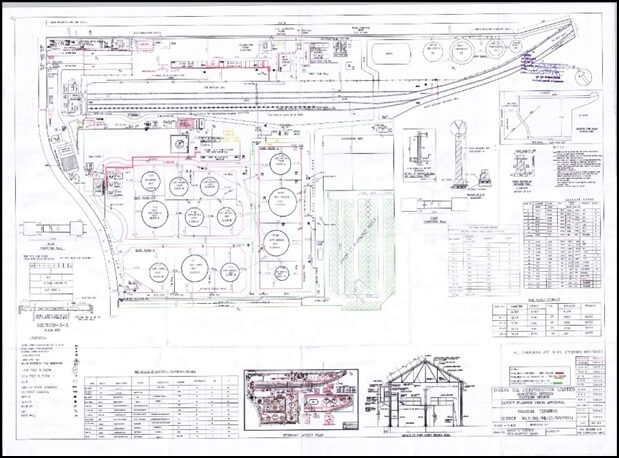M/S Indian Oil Corporation Limited (IOCL) has an existing isolated storage and terminal facility at Siliguri, West Bengal for petroleum storage and distribution terminal.
The terminal involves receipt, storage and distribution of finished petroleum products such as MS, HSD, SKO, ATF Ethanol & Bio-Diesel. The MS/HSD/SKO is received from Guwahati & Bongagaon Refinery through cross country pipelines (GSPL) and Ethanol/ Bio-Diesel is received by road TT. MS/HSD/SKO/ATF is also received by railway tank wagon from Barauni Refinery/ Bongaigaon Refinery/ Haldia Refinery/ Paradeep Refinery. IOCL additionally loads MS/HSD for Terminals located at various places as per demand. Delivery of product to various customers is undertaken by Tank Lorries and supplies to New Jalpaiguri railway by pipeline. This terminal is operative since 1962 with changes made as follows:
- Tank no 4, 10,22, 24, 29, 30, 26, 32, 33 & 402 have been dismantled.
- All vertical tanks are housed in four dykes.
- TK-34 converted from SKO service to MS Service
- TK-20 and TK-21 have been converted from class “C” to Class “B”.
- Railway siding line number 4&5 are now defunct and getting dismantled
iFluids Engineering has been entrusted to carry out QRA, HAZOP and ERDMP for IOCL- Siliguri Terminal, West Bengal and the study covers the different components and equipment’s associated with this facility
Objective-QRA
The main intention of QRA study is to appraise the potential risk levels for personnel due to accidental release of hazardous materials from LOC scenarios of the facilities and to illustrate that the individual risks lies within the acceptable region.
The Objectives of QRA are as follows:
- Association of Hazards and Major Loss of Containment (LOC) events.
- To quantify physical damage and effects of failure case scenarios which include reckoning of Jet Fire, Pool Fire heat radiation distances, Flammable gas dispersion distances, BLEVE and overpressure explosion distances.
- To evaluate Failure Frequency.
- To estimate Potential Loss of Life by evaluating Societal Risk.
- Risk assessment is performed to confirm that risk can be reduced consistent with the ALARP principle according to the UK HSE risk acceptance criteria.
- Recommend risk reduction measures to ensure that all risks lie in ALARP or Acceptable region.
Objective-HAZOP
The objective of the HAZOP study is to oblige in managing project risk through early identification of hazards and operability problems and to reduce the anticipation and consequences of an occasion that would have injurious impact to the personnel, plant, asset and environment.
Objective-ERDMP
The objective of this ERDMP is to identify emergencies which can arise during normal operations of IOCL-Siliguri Terminal and recommend mitigation measures to reduce and eliminate the risk or disaster, develop plans for actions during disaster or emergencies and keep prepared responses that mobilize the necessary emergency services including responders (primary, secondary and tertiary) like Fire service, Police service, Medical service including ambulance, Government and non-governmental agencies. This also comprises post calamity recovery with aim to retain the affected area to its indigenous conditions.
Overall Layout

